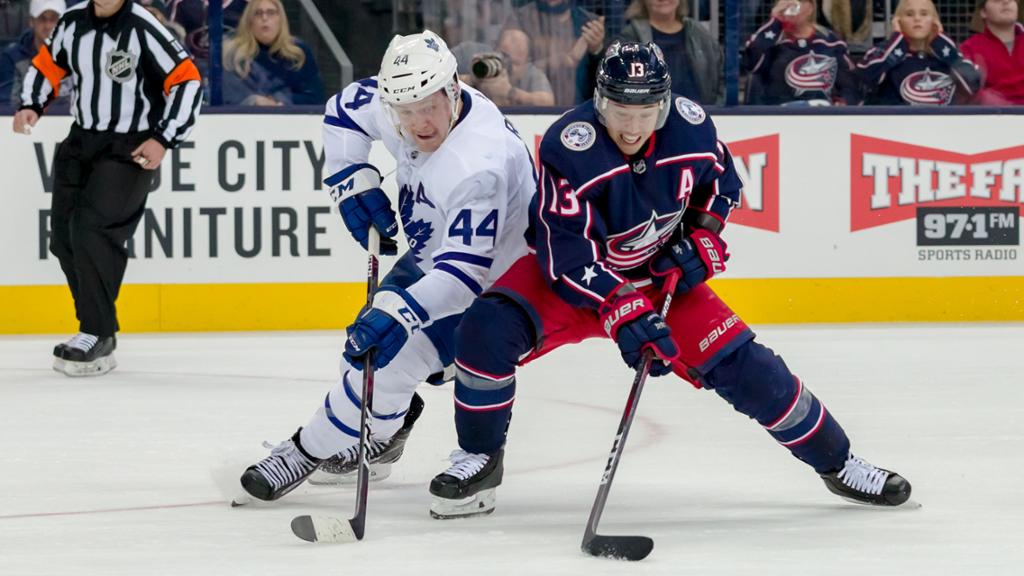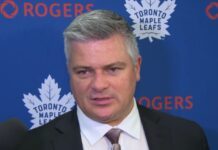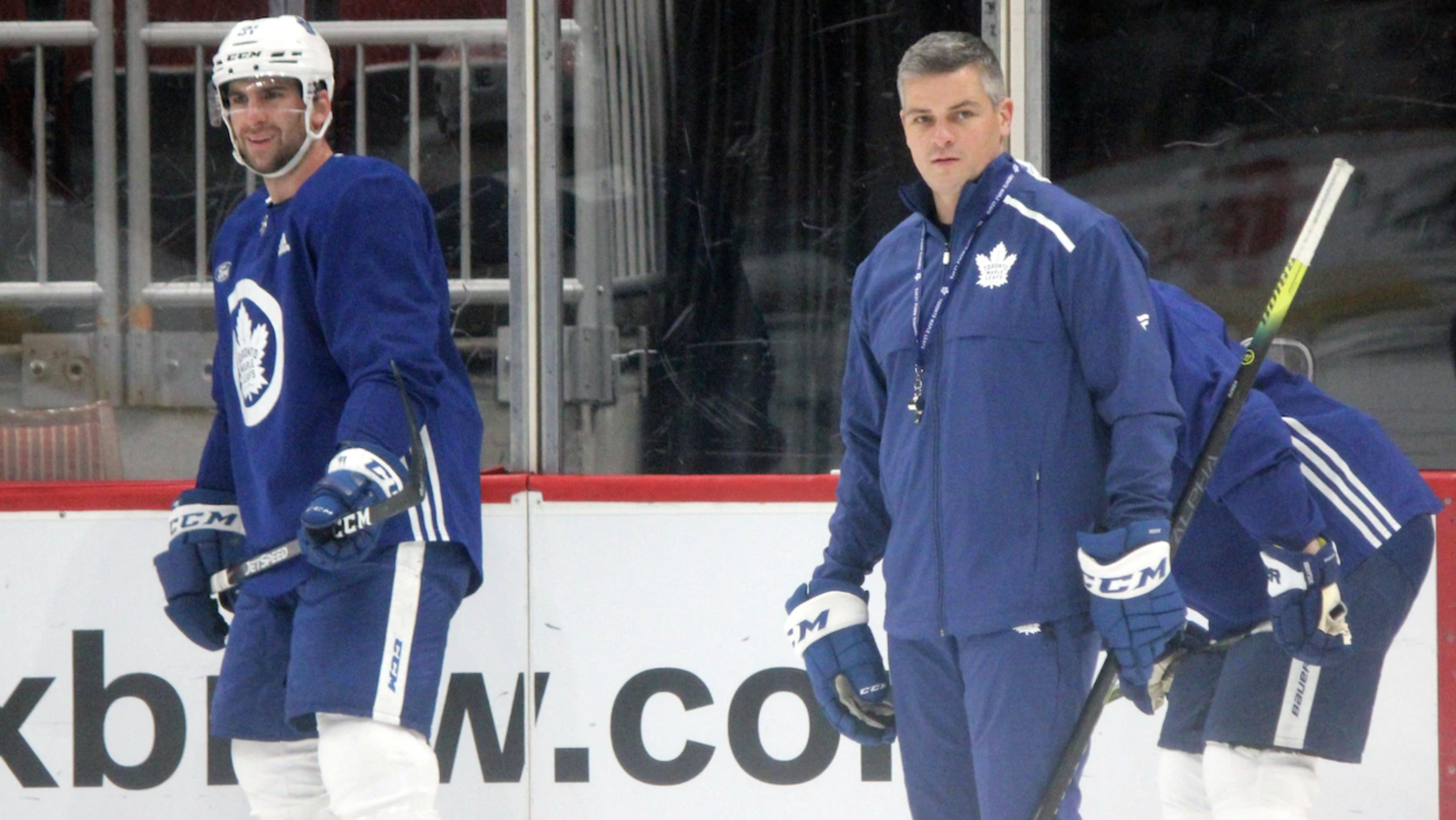Happy New Year, MLHS! It’s a little surreal to say at this point in the calendar, but the NHL is almost back.
It will feel strange to jump right into the season without a preseason, and I’d expect the first few games to be sloppier than usual as a result. With only a 56-game regular-season schedule, the margin for error is slim, and getting off to a poor start could prove to be a disaster. It’s reasonable to think that some teams that are maybe not the strongest on paper but are organized enough to hit the ground running could surprise us — especially in a league that rewards losing teams with three-point games. We saw this to some degree in the 48-game 2013 season (the Leafs, Islanders, and Sens all fell off the next season, for various reasons).
For the Leafs, they’ll also be going into the season with a bit more pressure than recent seasons. At first, they were a young team that exceeded expectations. They then signed John Tavares and further attempted to supplement the roster the following summer — only for all of these seasons to end in first-round losses. The frustration and the second-guessing has only mounted with each abrupt exit.
After a play-in round loss to the Columbus Blue Jackets (they technically did not make the playoffs last season), the heat on the team really picked up for the first time in years. There were calls for firings and for the trading of key players. Now, whether any of it was actually sensible is a story in and of itself, but there are pressures and expectations that are above and beyond the previous seasons. It’s hard to imagine another first-round exit this season (or worse) not resulting in some sort of major shakeup.
After their prompt exit from the bubble last year, Auston Matthews reflected:
Having a good regular season really isn’t cutting it anymore. We’ve got to figure out how to get out of the first round. It’s frustrating and a little embarrassing with the talent that we have on this team that we haven’t been able to pull through.
I’ve brought this quote up a few times since their early exit because I genuinely believe it’s an important moment of maturity. For years now, this Leafs team has turned it on and off as they please throughout the season, thinking they will simply find another level come playoffs. Mike Babcock cited it regularly, and Sheldon Keefe consistently spoke about the team’s lack of maturity once he took over behind the bench. There were more than a few head-scratching defeats last season.
The Leafs have taken steps to surround their young talent with proven, respected veterans this offseason. The lack of veteran leadership is something GM Kyle Dubas admitted was a mistake, one he looked to rectify last October. But accountability starts at the top of the roster and a motivated Matthews leading by example in some of the more detailed aspects of the game — focusing on defense a bit more, taking on opponent’s top players head to head, creating offense off the forecheck when the game slows down — would make a world of a difference.
Pretty well every team that wins it all deploys its top-line head-to-head against their opponent’s best and relies on their studs to come out on top (Sidney Crosby multiple times, Brayden Point last year, Jonathan Toews during Chicago’s run, Anze Kopitar during LA’s run). If Matthews is serious about taking the next step and making noise in the playoffs, that’s the next evolution for him.
I don’t think John Tavares is the one to do that night in and night out on the wrong side of 30, and Joe Thornton and whoever else the Leafs end up playing at center certainly aren’t, either. This is year five for Matthews, and he’s turning 24 in September. At some point, scoring a bunch of goals in the regular season and losing in the first round of the playoffs every year isn’t satisfying anymore.
As the team heads into camp, here are the first five of 10 questions I’ll be keeping an eye out for through the beginning of the regular season. The other five questions will follow in Part 2 tomorrow.
1. Who will flank Matthews (and by process of elimination, Tavares after that)?
Let’s continue on the Matthews note and start at the top of the roster. The Hyman – Matthews – Nylander line has been great when played together. Matthews and Marner also had moments of magic together and generally played together after Sheldon Keefe became head coach.
In fact, Marner was the player Matthews played the most with at 5v5 last season (though Nylander only played six fewer minutes with him overall). It would stand to reason that if you’re matching up Matthews against top lines, Marner is the winger beside Matthews while Nylander feasts offensively alongside John Tavares on the de facto second line.
2. How do Morgan Rielly and TJ Brodie look together?
I am assuming, based on their play together last season, that Jake Muzzin and Justin Holl will start the season together again. They were legitimately good alongside one another and the Leafs could reasonably trust them to play against top players, which is nothing to sneeze at (at 5v5 together they had over 52 CF%, over 54 Fenwick%, over 53 GF%).
That would mean Morgan Rielly and TJ Brodie are slated to start the season as pairing considering neither of those defensemen is getting paid that kind of money to play on the third pair; plus, of course, they are both good players who should play a ton.
Over the past four seasons, Rielly’s most common partners have been Nikita Zaitsev, Ron Hainsey, and Cody Ceci. He is receiving an upgrade this season. We’ve covered TJ Brodie at length, so I’m not going to go into too much detail here; he is good, although there are signs that he is in decline (and he will turn 31 this season). But he’s handled toughs before playing the right side while paired off with a lefty in Mark Giordano.
Rielly isn’t as good as Giordano (and that’s no knock on him; Giordano was elite). How they fit together as a pairing is a big question because we already know they have one solid pairing. Could we actually see a Leafs team with two strong defensive pairings for once? On paper, the fit makes sense.

3. Who wins the final two spots on the Leafs defense?
The obvious answer is that this will be a rotation throughout most of the season and we won’t see this finalized until after the trade deadline or so. There are a number of candidates to round out the defense; they’ll all receive opportunities, and they mostly all bring different skill sets.
The Leafs can choose from Travis Dermott, Zach Bogosian, Mikko Lehtonen, and Rasmus Sandin, and to a lesser extent, Timothy Liljegren and Martin Marincin. I am guessing that the two most established players receive the first look – a Dermott, Bogosian pairing. From the outside, Lehtonen would be the best set up for success with power-play time and there is definitely a chance he could get a look on the second power-play unit – potentially even competing with Rasmus Sandin for that role.
Lehtonen is also not some young prospect that is developing — he’s 27. While he might need some time to adjust to the league, the rope doesn’t go particularly far when you factor in his age.
And then there is Sandin, who showed quite well last year, including quarterbacking the power play and generally looking ready for a regular role. The Leafs have made it quite difficult for him entering camp now, but it wouldn’t be shocking if he gave them no choice but to play him at some point in the season. I just can’t picture it happening right out of camp.
4. How will the top prospects be managed?
On the note about Sandin: How will the Leafs manage their young prospects, particularly Sandin and Nick Robertson, in this oddball season?
The AHL is not slated to begin until February. With taxi squad rules, players are permitted to travel with the NHL squad, practice with them, and join in on any team activities. They are not allowed to practice with any other group besides the NHL team, and that includes practicing or joining in on any AHL functions.
I’d imagine the Leafs brass will keep the likes of Sandin and Robertson around, rotate them in the lineup sporadically, and if they earn longer looks, they will receive them.
Beyond that, we will see how many opportunities these players are given when they do dress – will Sandin get the aforementioned power-play time? Will Robertson get some shifts with Matthews/Tavares or stick to the bottom lines?
Every team is walking a fine line between trying to win as much as possible while also continuing to developing their prospects. But the NHL is ultimately about winning, and I’m not sure either of these two helps them win more than their more experienced peers (at least to start the season). They’ll have to force their way into the lineup.
5. Who are the third and fourth line centers?
In the playoffs last year, the Leafs’ third and fourth line centers were Kerfoot and Engvall. It was a position of weakness for them, and when Keefe decided to load up the top line for the do-or-die Game 5, it was a bit of an indictment of their other two centers. Instead of one of them getting promoted up the lineup, they moved Nylander to play center and fill the spot.
At center, the Leafs only really added Thornton. While Spezza can play some center, he’s more of a winger at this point in his career. My initial guess would be Thornton plays 3C, Kerfoot moves to the wing, and Engvall continues as 4C.
I’m interested to see if the coaching staff gives Nylander more looks at center this season, although it might be as a top-six center (I’d argue that a Matthews-Tavares-Nylander look at center could be an interesting experiment at times). If Thornton and Kerfoot end up on the same line, it’s realistic to think that they could split duties at center, with Kerfoot handling some of the heavy lifting defensively to make Thornton’s life a bit easier at this stage of his career.


































